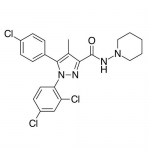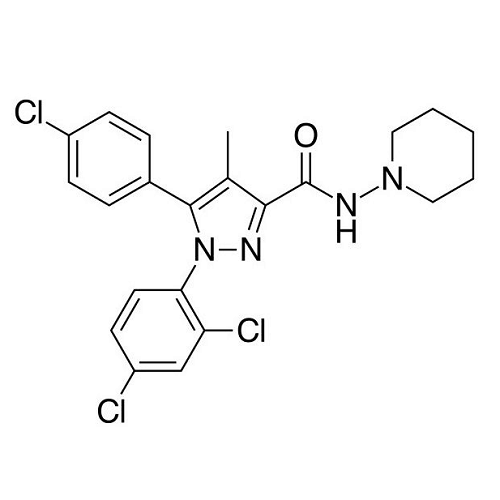| Product Name | Rimonabant |
| Description |
CB1 Receptor Antagonist |
| Purity | >98% (TLC); NMR (Conforms) |
| CAS No. | 158681-13-1 |
| Molecular Formula | C22H21Cl3N4O |
| Molecular Weight | 463.8 |
| Field of Use | Not for use in humans. Not for use in diagnostics or therapeutics. For in vitro research use only. |
Properties
| Storage Temperature | -20ºC |
| Shipping Temperature | Shipped Ambient |
| Product Type | Inhibitor |
| Solubility | Soluble in DMSO (50 mg/ml) |
| Source | Synthetic |
| Appearance | White powder |
| SMILES | Cc1c(n(nc1C(=O)NN2CCCCC2)c3ccc(cc3Cl)Cl)c4ccc(cc4)Cl |
| InChI | InChI=1S/C22H21Cl3N4O/c1-14-20(22(30)27-28-11-3-2-4-12-28)26-29(19-10-9-17(24)13-18(19)25)21(14)15-5-7-16(23)8-6-15/h5-10,13H,2-4,11-12H2,1H3,(H,27,30) |
| InChIKey | REOYOKXLUFHOBV-UHFFFAOYSA-N |
| Safety Phrases |
Classification D1B Toxic Material Causing Immediate and Serious Toxic Effects - Toxic by ingestion D2B Toxic Material Causing Other Toxic Effects - Moderate eye irritant Hazard statement(s): H301 Toxic if swallowed. H319 Causes serious eye irritation. Precautionary statement(s): P301 + P310 IF SWALLOWED: Immediately call a POISON CENTER or doctor/ physician. P305 + P351 + P338 IF IN EYES: Rinse cautiously with water for several minutes. Remove contact lenses, if present and easy to do. Continue rinsing. |
| Cite This Product | Rimonabant (StressMarq Biosciences Inc., Victoria BC CANADA, Catalog # SIH-528) |
Biological Description
| Alternative Names | 5-(4-Chlorophenyl)-1-(2,4-dichlorophenyl)-4-methyl-N-1-piperidinyl-1H-pyrazole-3-carboxamide hydrochloride, SR-141716, SR-141716A, SR141716, SR141716A |
| Research Areas | Cell Signaling, Neuroscience, Neurotransmitter Receptors |
| PubChem ID | 104849 |
| Scientific Background | Rimonabant is a selective cannabinoid receptor type 1 (CB1) antagonist that was originally developed as an anti-obesity drug. In neuroscience, it has been studied for its effects on the endocannabinoid system, which plays a critical role in mood regulation, appetite, and neuroprotection. Rimonabant's ability to modulate CB1 receptor signaling has implications for treating neuropsychiatric disorders, including depression and anxiety. Additionally, its influence on neuroinflammation and synaptic plasticity positions it as a candidate for research in neurodegenerative diseases, although its clinical use has been limited due to psychiatric side effects. |



Reviews
There are no reviews yet.